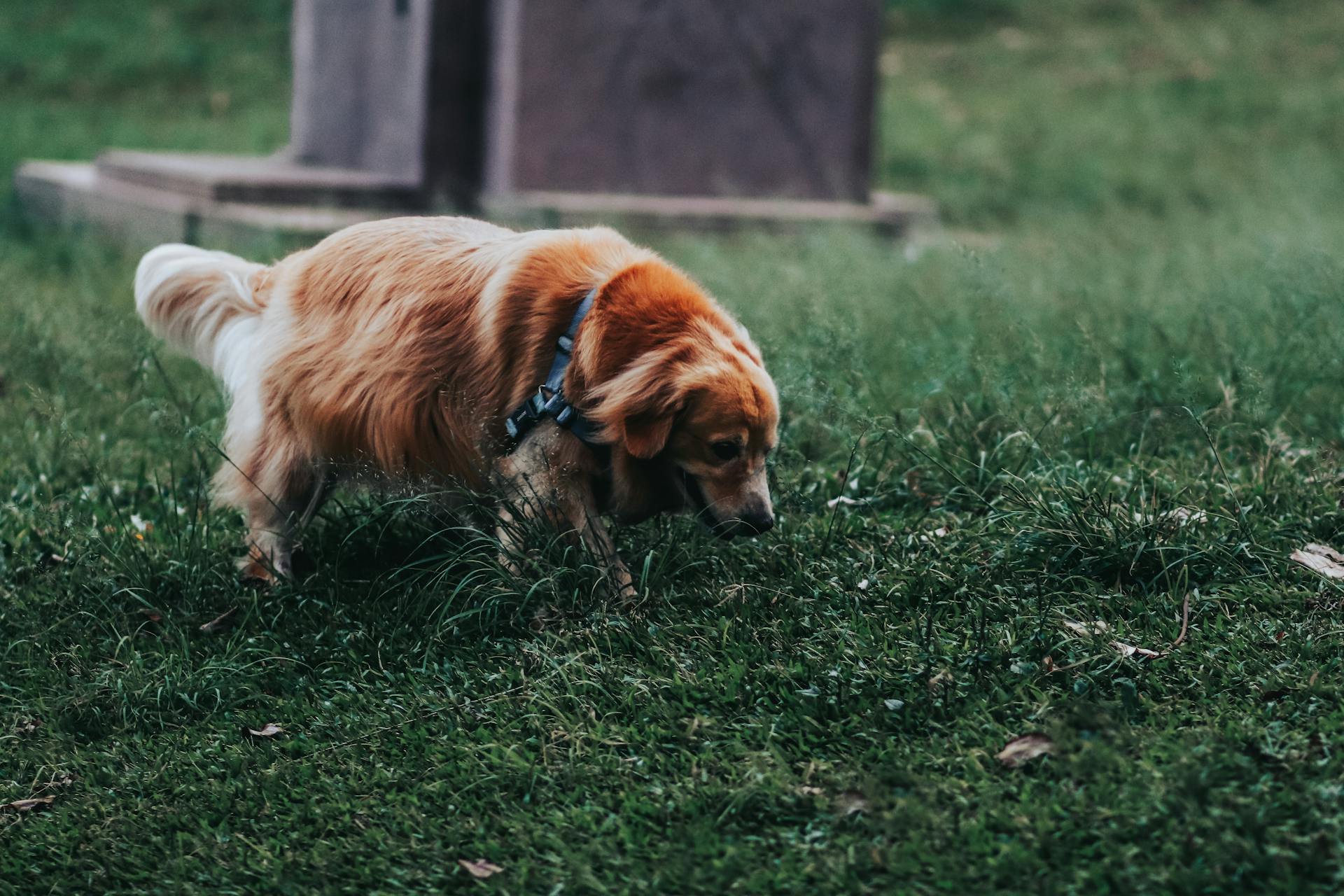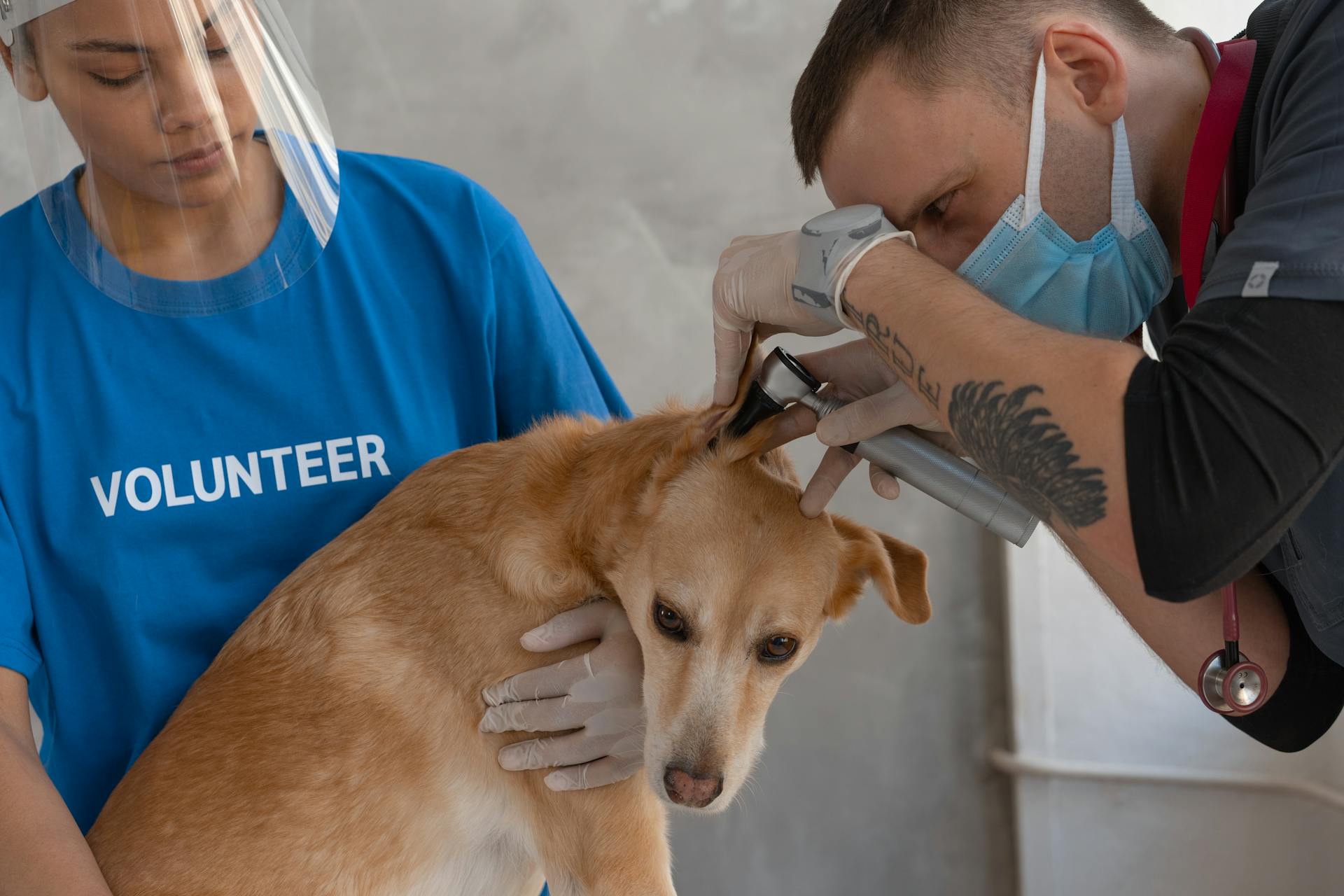
Unspayed female dogs can exhibit a range of behaviors that are not only frustrating but also indicative of underlying health issues.
Dogs in heat can be restless and agitated, pacing back and forth in search of a mate.
This restlessness can be exhausting for both dog and owner, and may even lead to destructive behavior if not addressed.
Female dogs in heat often attract unwanted male attention, which can be a significant problem for owners who want to prevent unwanted breeding.
Some unspayed female dogs may become overly clingy or demanding of attention, seeking constant reassurance and affection.
This clinginess can be a sign of anxiety or stress related to their reproductive cycle.
In addition to these behavioral changes, unspayed female dogs are also at risk of developing certain health issues, such as uterine infections and breast tumors.
You might enjoy: Can a Female Dog Get Pregnant When Not in Heat
Pseudocyesis
Pseudocyesis is a phenomenon where an unspayed female dog displays maternal behavior and physical signs of pregnancy, even though she's not actually pregnant. This can happen at any age and doesn't necessarily follow every estrus cycle.
The signs of pseudocyesis usually begin four to nine weeks after the previous heat period and can mimic the signs of true pregnancy. These signs include mammary gland enlargement, lethargy, periodic vomiting, and fluid retention.
Dogs with pseudocyesis often have a decreased appetite but seldom lose weight, likely due to excess fluid retention. Behavioral changes also occur, including nesting, mothering activity, restlessness, decreased interest in physical activity, and occasionally even aggression.
Some affected dogs show signs of false labor and then protectively guard toys or other small objects. If you suspect your dog is experiencing pseudocyesis, your veterinarian can perform an ultrasound or X-rays to assess for pregnancy.
Additional reading: Signs a Female Dog Is Ready to Mate
Female Dog Cycle
A female dog's heat cycle can be a complex and fascinating process. The cycle typically lasts between 2-4 weeks and is divided into four stages: proestrus, estrus, diestrus, and anestrus.
During proestrus, the female dog's vulva will start to swell and she will have a light, bloody discharge. This stage can last anywhere from 3-17 days, on average 7 days. Some dogs may become more affectionate and clingy, while others may get grumpy and stressed.
Worth a look: Female Dog Estrous Cycle
The estrus stage is when the female dog is fertile and can get pregnant. This stage typically lasts around 9 days and is characterized by a swollen vulva and a reddish-brown discharge. The dog will also be more receptive to male company and may even flirt with them by raising her tail and moving it to one side or the other.
Diestrus occurs directly after estrus and is a time of rest for the female dog's body. This stage can last anywhere from 58-68 days, on average 60 days. The vulva returns to normal size and discharge dries up.
Anestrus is the final stage of the heat cycle and is a period of inactivity or rest. Hormone levels return to normal during this phase, which can last anywhere from 100-150 days.
Here's a breakdown of the average length of each stage:
It's worth noting that not all dogs will have heat cycles that follow this exact timeline, and some may have cycles that are shorter or longer. Regular veterinary check-ups can help identify any irregularities and rule out underlying health problems.
Physical Characteristics
As an unspayed female dog gets closer to heat, her physical characteristics change to attract a mate. Her vulva will begin to swell and darken in color.
Her urine will also become more pungent due to the hormonal changes in her body. This is a sign that she's in heat and ready to mate.
As her heat cycle progresses, her discharge will change from a clear or cloudy liquid to a more reddish-pink color. This is a signal to other dogs that she's fertile and ready to breed.
A unique perspective: Does Spaying a Female Dog Calm Them down
Female Physical Characteristics
A female dog in heat can be a bit of a mystery, but there are some clear physical signs to look out for. The vulva will swell and redden, making it a bit more noticeable.
You may notice a discharge from the vulva, which can start off as bloody and become more yellowish or brownish as the heat cycle progresses. This discharge can be a bit messy, so be prepared to clean up after your dog.
See what others are reading: Why Does My Female Dog Have Discharge

The first sign of heat is often swelling of the vulva, which may be accompanied by a slight discharge. This is usually the most obvious sign that your dog is in heat.
As the heat cycle progresses, the discharge may become more pronounced and may be tinged with blood. This can be a bit alarming, but it's a normal part of the heat cycle.
Here are the key physical signs of a female dog in heat:
- Swelling of the vulva
- Blood-tinged discharge
It's worth noting that the vulva may become swollen and red, making it a bit more noticeable.
Do Have Periods?
Dogs do not have menstrual periods like humans do, but they do have a reproductive or heat cycle.
During a heat cycle, a female dog becomes fertile and can become pregnant.
A heat cycle is controlled by hormones, specifically an increase in estrogen levels, followed by a sharp decrease in estrogen and finally, the releasing of eggs from their ovaries.
A unique perspective: How Old Is a Female Dog in Heat
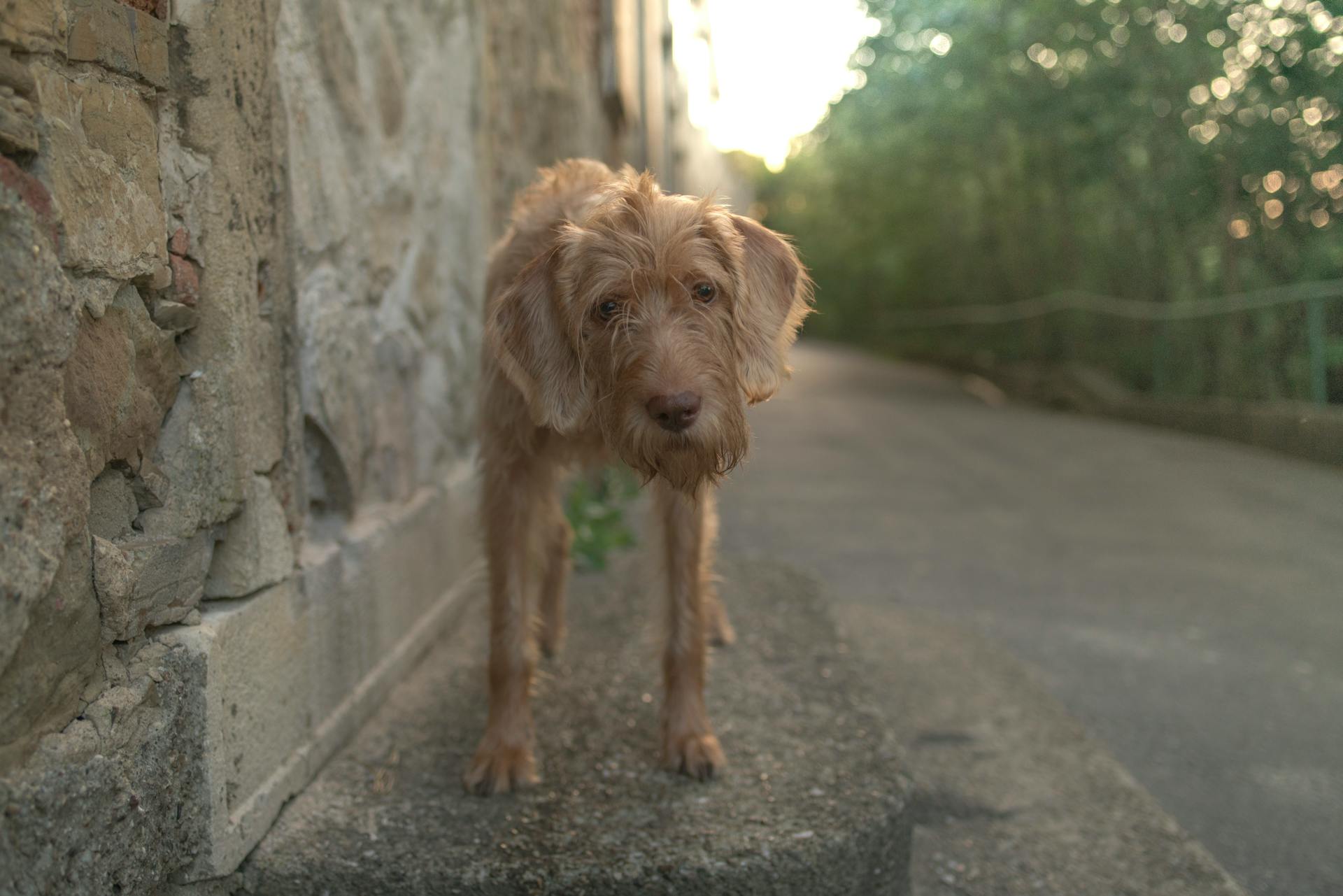
As a result of this process, a female dog may have a bloody discharge from her vulva, similar to a human period or menstruation.
However, this bleeding is not caused by the shedding of the uterine lining, but rather a combination of blood, mucus, and other fluids released from the dog's cervix.
This is a crucial distinction to make, especially if you're a new dog owner trying to understand your pet's behavior and physical changes.
Readers also liked: Dog Names Female Start with S
Behavioral Signs
A dog in heat will often become receptive to male dogs, welcoming their advances and even trying to mount other pets in the home.
Agitated, nervous, or aggressive behavior is common during the first phase of estrus, with some dogs becoming aggressive towards other pets or even their owners.
You may notice your dog licking her genital area excessively, a sign that she's in heat.
Urinating more frequently is another common sign, as dogs in heat tend to alert male dogs in the area that they're receptive to mating.
Curious to learn more? Check out: Most Common Dog Names Female
Some dogs may also exhibit a change in tail position, holding it to the side as a signal to male dogs that she's ready to breed.
Here are some key behavioral signs to look out for:
- Increased irritability, potentially growling at people or other pets
- Increased stress and restlessness
- Roaming and escaping to look for male dogs to mate with
- Changes in appetite, resisting food or becoming more ravenous
- Flagging, raising her tail and holding it to the side
Signs of False Pregnancy
Signs of false pregnancy can be quite confusing, especially if you're not sure what to look for. They usually begin four to nine weeks after the previous heat period.
Mammary gland enlargement with or without milk production is a common sign of pseudo-pregnancy in dogs. Some dogs may also experience lethargy, which can be a bit concerning if you're not aware of what's going on.
Periodic vomiting and fluid retention are also possible signs of false pregnancy. Your dog might not lose weight due to the excess fluid, but their appetite may decrease.
Behavioral changes can also occur during pseudo-pregnancy, including nesting and mothering activity. Some dogs may even become protective of toys or small objects.
Restlessness and decreased interest in physical activity are other signs of false pregnancy you might notice. In some cases, dogs may even show signs of false labor.
Curious to learn more? Check out: Risks of Not Spaying Female Dog
Expecting First Child?
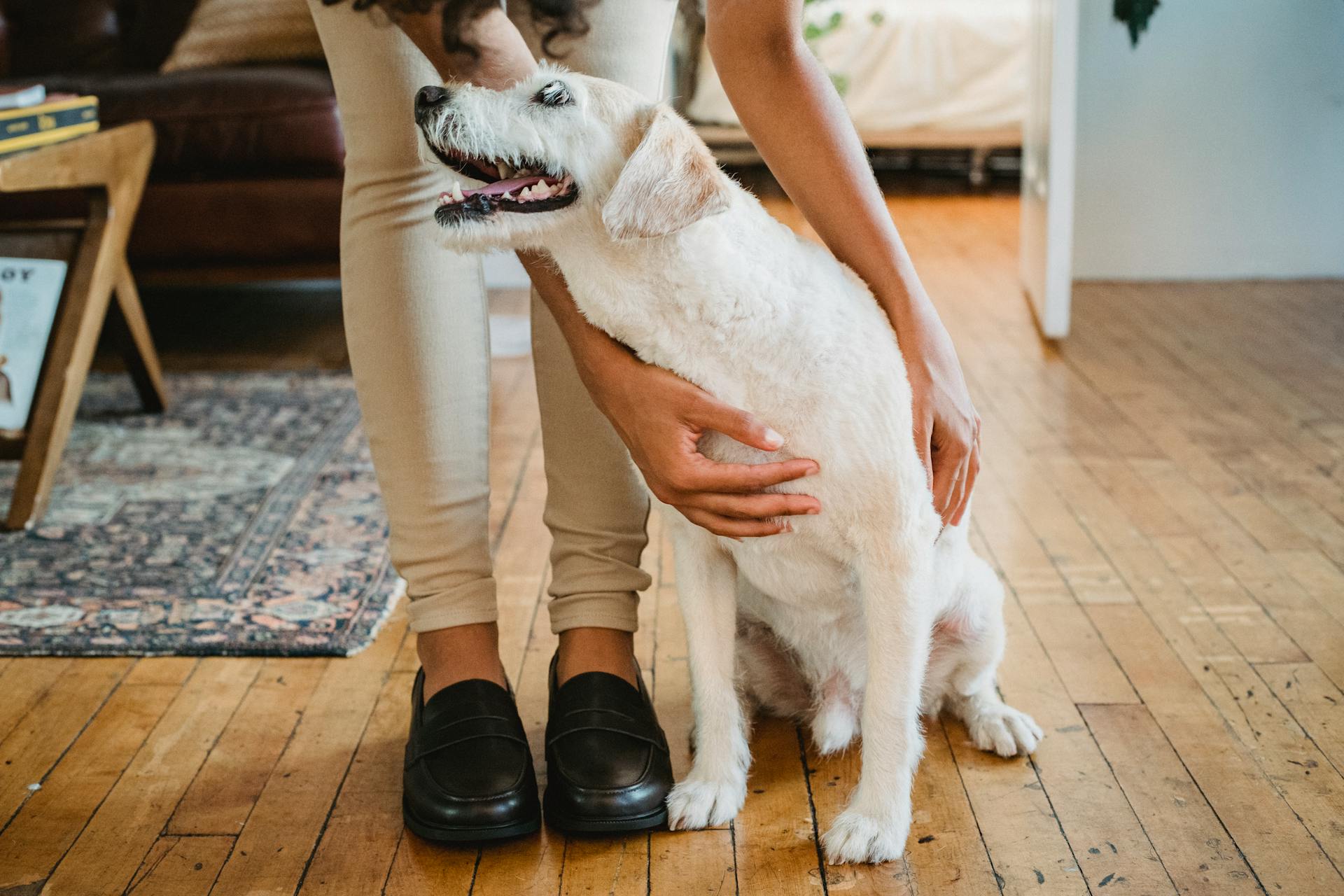
Most dogs will begin their first heat cycle between six and 15 months of age. Toy breeds can come into heat for the first time as young as four months, while large and giant breeds may be as old as two years before experiencing a first heat cycle.
The first heat cycle often is missed by pet parents, which is why many veterinarians advocate for spay surgery at 6 months of age to prevent unwanted pregnancies. If your dog goes into heat and has sex with a male dog, then she can get pregnant, even if she herself is still growing.
Small dog breeds can cycle every 3-4 months, medium and large breeds typically cycle every 6 months, and giant breeds may only cycle every 6-12 months. Bleeding during proestrus typically lasts around 7 days.
The timing of a dog's heat cycle can vary depending on the individual dog and her breed, but most dogs will reach sexual maturity and have their first heat cycle between six and twelve months of age.
For more insights, see: At What Age Should a Female Dog Be Spayed
How Often Do You Go
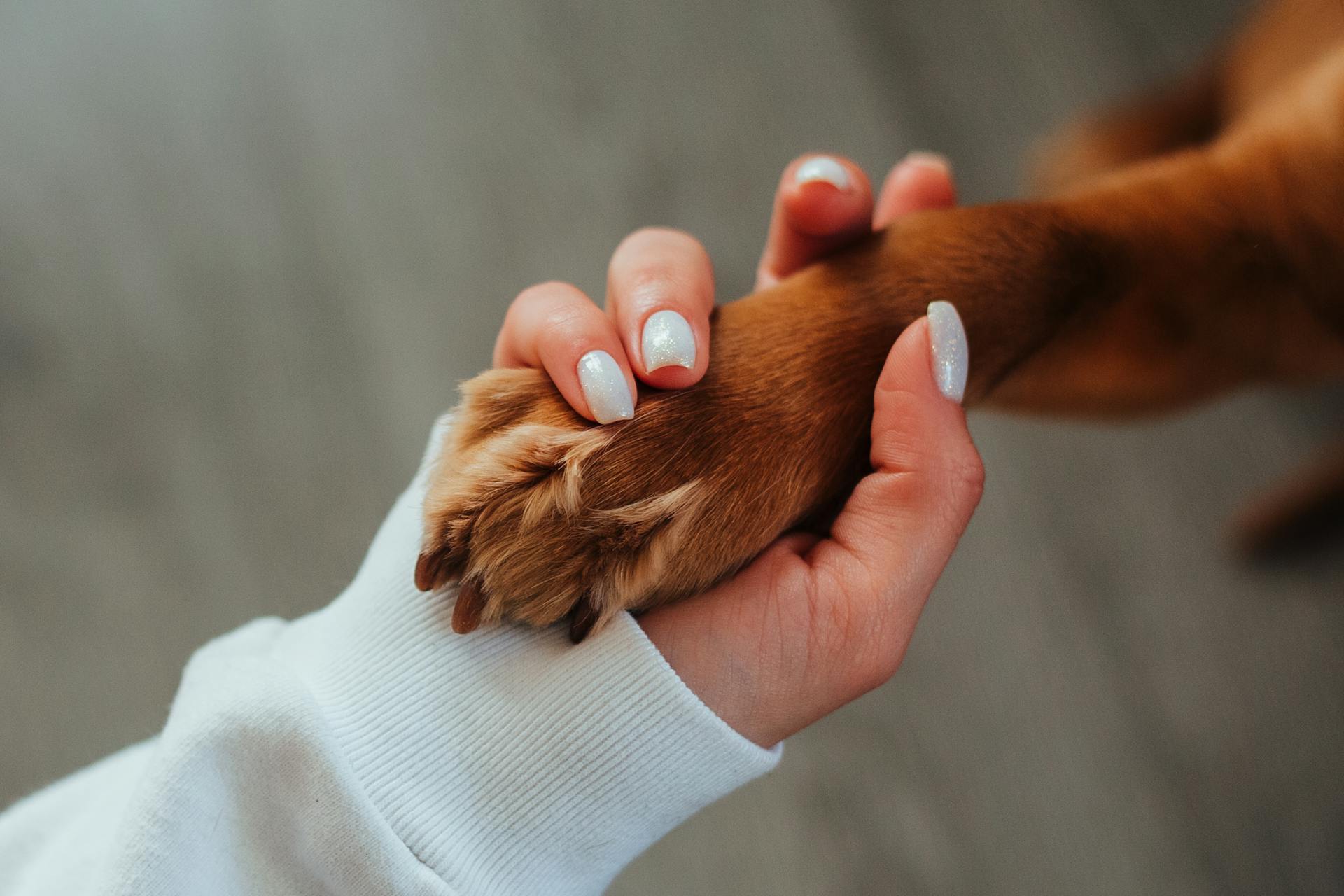
Your dog's heat cycle is a natural process, but it can be unpredictable. Dogs typically have an average of two heat cycles per year, which can be roughly six months apart.
Some breeds may cycle more frequently, such as small breeds that can cycle every 3-4 months. Others, like giant breeds, may only cycle every 6-12 months.
The frequency of heat cycles can vary depending on your dog's age, size, and breed. Small dog breeds tend to go into heat more often, while large breeds and older dogs may go longer stretches between heats.
It's essential to keep track of your dog's cycle to prevent unwanted pregnancies. If you're unsure about your dog's heat cycle, consult with your veterinarian for guidance.
Here's a rough estimate of how often different breeds may cycle:
Remember, every dog is unique, and their heat cycle can be influenced by factors such as overall health, nutrition, and environment.
Signs
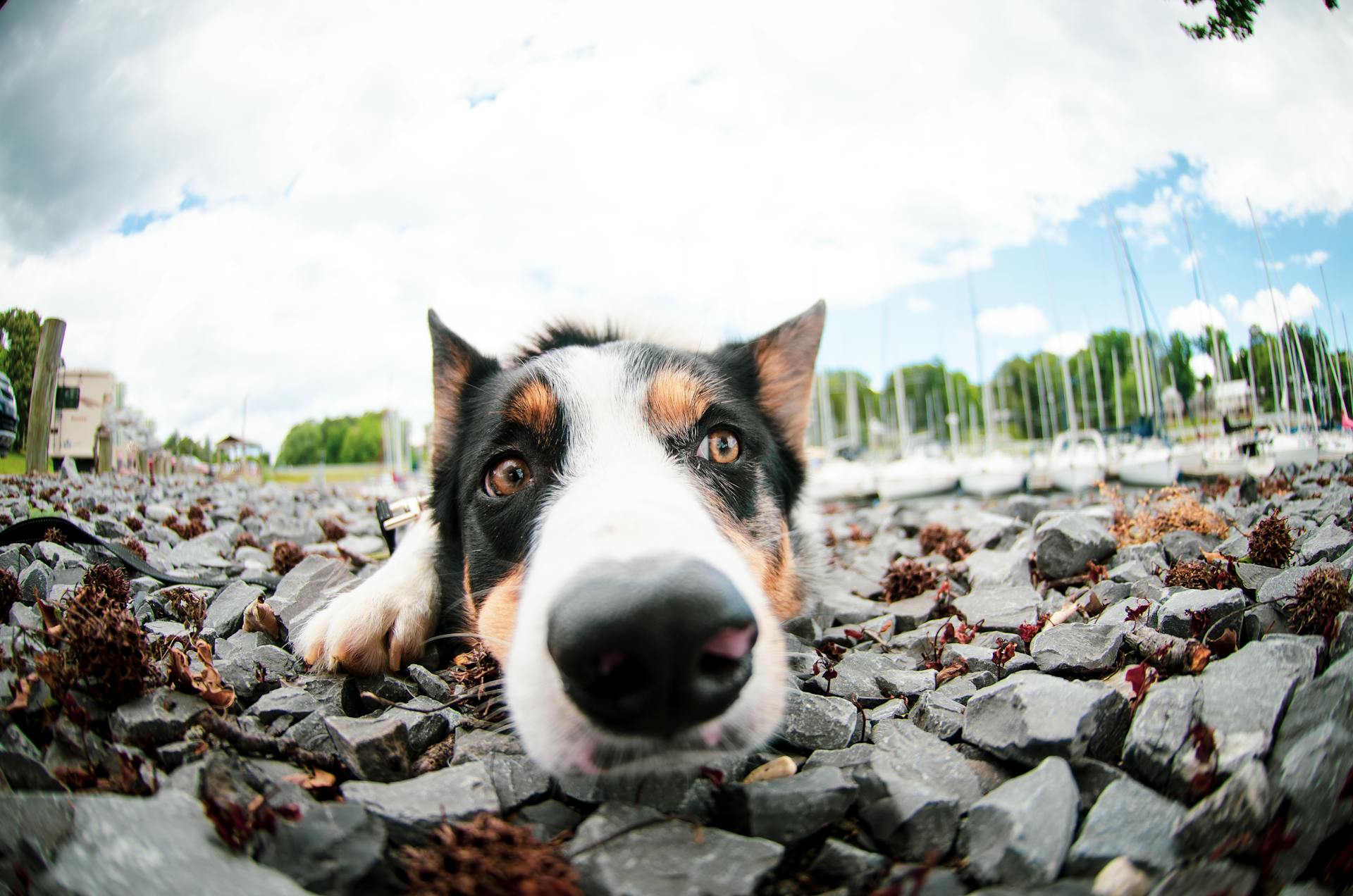
As a dog owner, it's essential to recognize the behavioral signs of a female dog in heat. These signs can be subtle, but knowing what to look out for can help you prepare your furry friend for this natural process.
Dogs in heat will often become receptive to male dogs, allowing them to mount and even trying to mount other dogs, including other female dogs. They may also become aggressive towards other household pets or even towards you.
Increased licking of the genital area is a common behavior in female dogs in heat. They may also urinate more frequently, as a way of alerting male dogs in the area that they are receptive to mating.
A change in tail position is another sign to look out for. At the beginning of the heat cycle, a female dog's tail may be tucked close against her body, but as estrus progresses, she may hold her tail to the side, signaling that she's ready to breed.
Curious to learn more? Check out: Female Dog Bladder Infection Symptoms
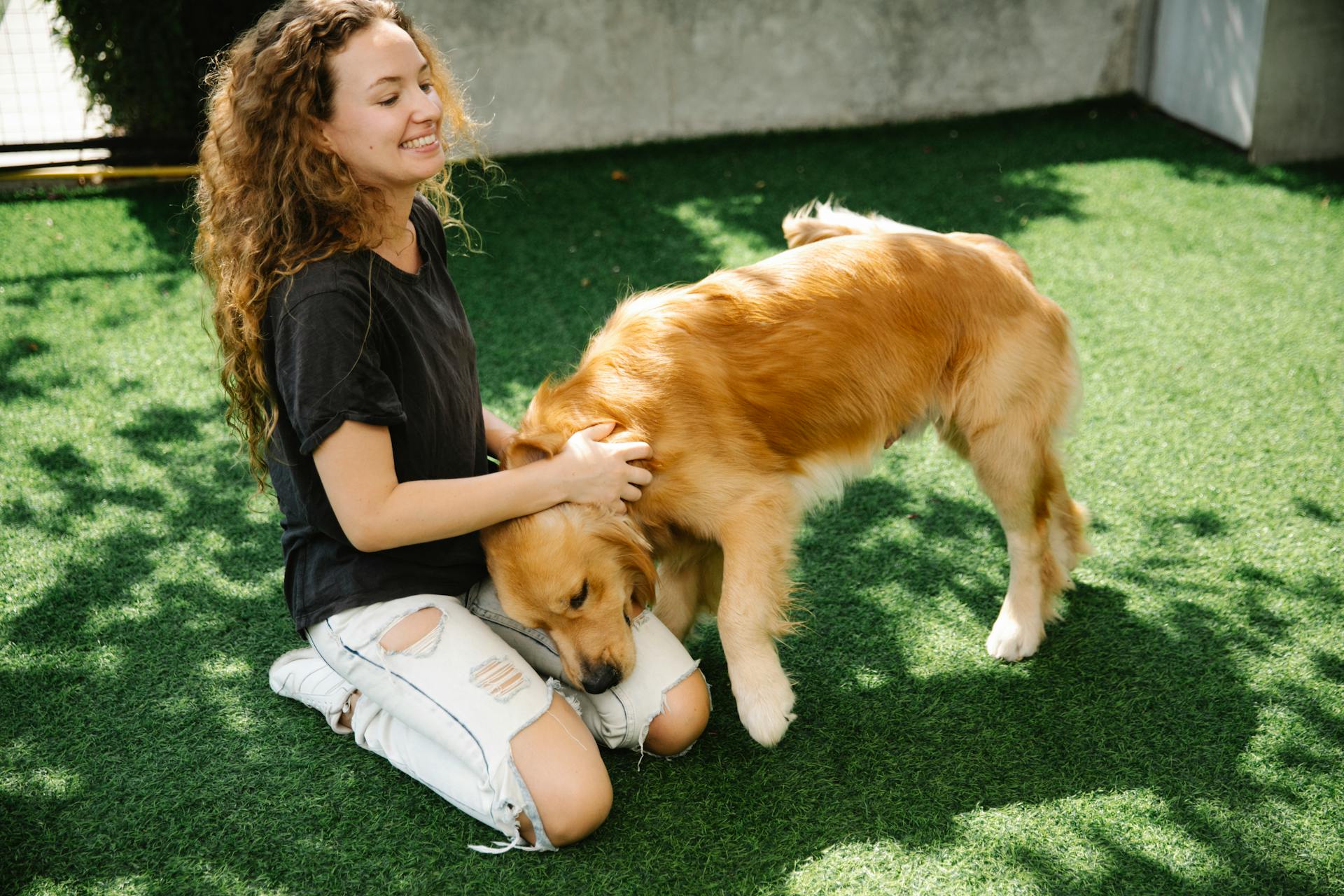
Some dogs may become more skittery or nervous during the first phase of estrus, while others may become aggressive towards other female dogs but welcoming to male dogs.
Here are some key behavioral signs to look out for:
- Increased irritability and moodiness
- Increased stress and restlessness
- Roaming and escaping to look for male dogs
- Changes in appetite, such as resisting food or becoming more ravenous
- Flagging, where the dog raises her tail and holds it to the side
Keep in mind that every dog is different, and not all female dogs will exhibit all of these signs. However, being aware of these behavioral cues can help you provide the care and attention your furry friend needs during this time.
Pregnancy and Spaying
Having an unspayed female dog can lead to unwanted pregnancies, which can be a real challenge. This is especially true if you're not prepared to care for a litter of puppies.
Spaying your dog eliminates her ability to reproduce, which is a significant benefit. In fact, spaying can prevent disease and some undesirable behaviors associated with mating instincts.
The procedure also stops the heat cycle and bleeding, which can be a relief for many dog owners. Your veterinarian will likely recommend waiting until at least one month after her heat cycle ends before spaying your dog.
Check this out: Female Dog Heat Cycle Chart
If you're not planning to breed your dog, spaying is a great option. It's a permanent solution that can save you from dealing with unwanted pregnancies and pet overpopulation.
Here are some benefits of spaying your female dog:
- Reduced risk of certain types of cancers, disease, and infections, including pyometra
- Curbed unwanted behaviors associated with mating
- Increased life expectancy
- Lower long-term healthcare costs
- Limited unwanted pregnancy and pet overpopulation
It's worth noting that most female dogs can be spayed any time after eight weeks of age, and preferably before their first heat for the best health benefits. Your veterinarian will be able to provide guidance on the best time to spay your dog based on her individual needs.
Consider reading: Best Female Dog Names Unique
Preparing for Spaying
Your vet can help determine the best time to spay your female dog, considering her individual needs. They'll take into account her breed and age to make a recommendation.
Most female dogs can be spayed after eight weeks of age, but it's often recommended to wait until they're close to their first heat cycle, which occurs around six to seven months of age. This is because they're more likely to tolerate the anesthesia.
Your dog's size shouldn't affect whether or not you decide to spay her, but it may influence the optimum time to do so.
Check this out: How to Tell the Age of a Female Dog
Spay Time
Spaying is a crucial decision for any dog owner, and timing is everything. Your vet can help you determine the best time to spay your female dog, considering her individual needs.
Most female dogs can be spayed after eight weeks of age, and ideally before their first heat cycle for the best health benefits. The first heat cycle usually occurs around six to seven months of age, depending on the breed.
Your vet might recommend waiting until your dog is close to that age to spay, as they are more likely to tolerate the necessary anesthesia. However, a fully-grown, larger dog can be more difficult to spay than a smaller dog.
If you adopt an older, unaltered female dog, you'll need to account for her heat cycle before surgery. Vets usually won't recommend spaying while your dog is in heat, as it can complicate the surgery.
Here's a rough guide to help you plan:
Keep in mind that your dog's size should not factor into whether or not you get her spayed at all. Vets are capable of spaying any size of dog, but size may affect the optimum time to spay and make things easier or harder for the vet.
Additional reading: Female Dog Not Spayed
How to Prepare
As you prepare for spaying your dog, it's essential to consider how to prepare for the heat cycles your unspayed female dog will experience beforehand. To prevent unwanted pregnancies, bloody messes, escapes, or aggression, you'll want to track her heat cycles.
Use a calendar, either on your phone or a paper one, to record the day her heat cycle started. Set a reminder for 6 months in the future with a 1-week alert ahead of time so you know it's coming. This will give you a head start on preparing for the next cycle.
If you're concerned about bloody messes, consider keeping dog diapers on hand. You can opt for washable diapers like Pet Parents washable dog diapers or disposable diapers like Simple Solution disposable female diapers. Alternatively, you can use human diapers and make them dog-friendly by cutting a hole for her tail.
If your dog has a hard time getting along with other canines while in heat or tries to escape, you might want to separate her in a secure area until she's done. A gate like Regato's walk-through pet gate can help keep her contained in another room.
For more insights, see: I Want to Breed My Female Dog
What to Do If My Is?
If your dog is in heat, it's essential to take precautions to ensure her safety and well-being. Never let your dog out in the yard alone, as a male dog's drive to find a female in heat can be overwhelming.
If you do let your dog out, you may come back to find a strange male dog tied to your female. This can be a stressful situation for both you and your dog.
Make sure your dog's ID tags and microchip information are up-to-date, so you can be reunited with her if she escapes. This is crucial, especially during her heat cycle when she's more likely to run off.
If you notice any signs of illness in your dog after a heat cycle, consult your veterinarian immediately. A common health issue that can arise is pyometra, a life-threatening uterine infection that can cause excessive drinking or urination, thick vaginal discharge, or loss of appetite.
Considering spaying your dog after her heat cycle is over is a good idea, especially if you have no plans to breed her. Your veterinarian can advise you on the best time to spay your pet, and will likely recommend waiting until she's finished with her estrus phase.
What to Do
Before the spaying surgery, schedule a pre-surgical examination with your veterinarian to discuss any health concerns and confirm the procedure details.
Plan to withhold food and water from your pet for 8 to 12 hours before the surgery to minimize the risk of complications.
Take your pet to the clinic on the scheduled day, bringing any required documents and information about your pet's medical history.
Follow the veterinarian's instructions for post-operative care, which may include monitoring for signs of infection, administering pain medication, and keeping your pet calm and quiet.
Keep an eye on your pet's incision site for any signs of infection, such as redness, swelling, or discharge, and contact your veterinarian if you have any concerns.
On a similar theme: How Long Is a Spay Surgery for Female Dog
Frequently Asked Questions
Do female dogs behave better after being spayed?
Spaying female dogs can lead to a decrease in aggression due to reduced estrogen levels. This change in behavior can make them more pleasant companions, but it's essential to understand the entire process and its effects.
Sources
- https://vcahospitals.com/know-your-pet/false-pregnancy-or-pseudopregnancy-in-dogs
- https://www.thesprucepets.com/signs-your-dog-is-in-heat-3385379
- https://be.chewy.com/preparing-for-a-dog-in-heat/
- https://www.ellevetsciences.com/pet-care/do-dogs-have-periods-all-about-female-dogs-heat-cycles/
- https://dogtime.com/dog-health/general/42-spaying-your-female
Featured Images: pexels.com
